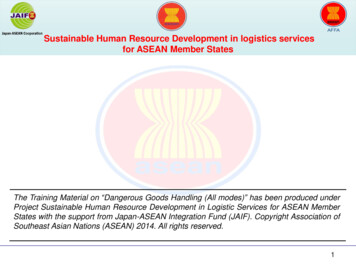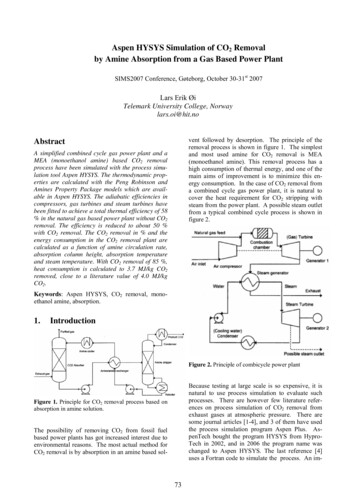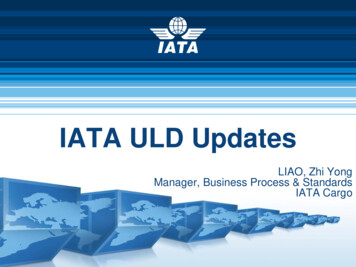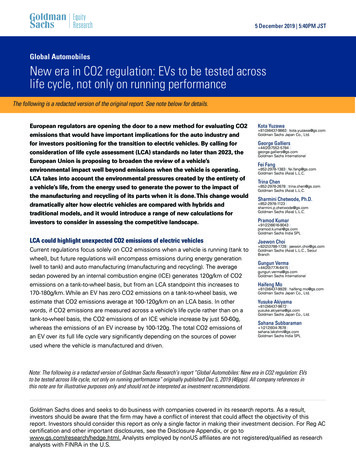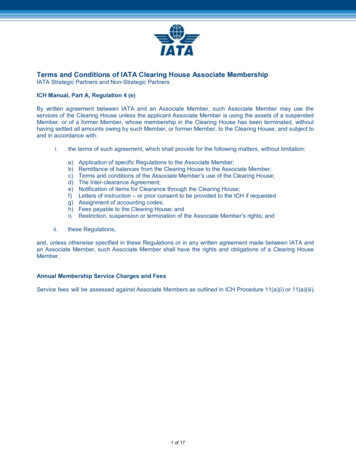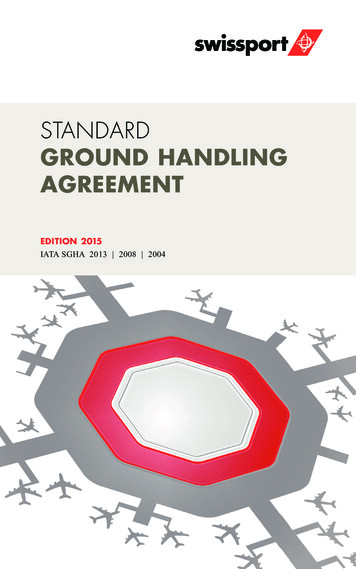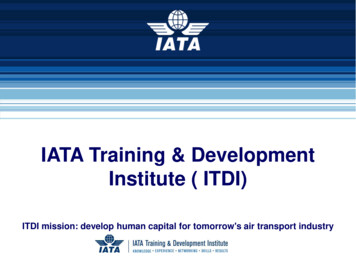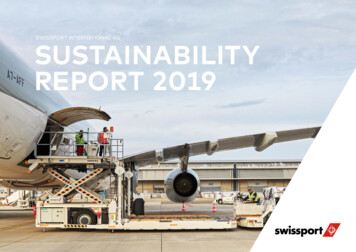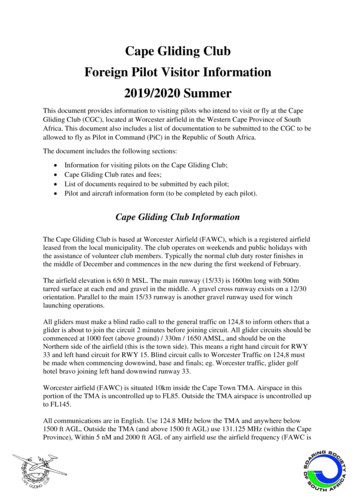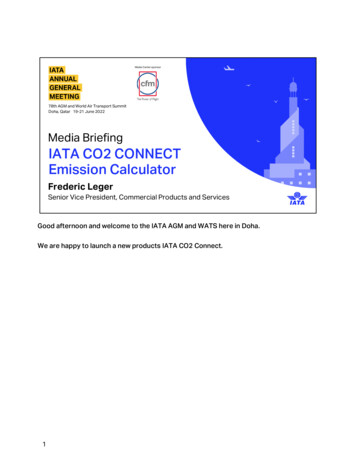
Transcription
Media Center sponsor78th AGM and World Air Transport SummitDoha, Qatar 19-21 June 2022Media BriefingIATA CO2 CONNECTEmission CalculatorFrederic LegerSenior Vice President, Commercial Products and ServicesGood afternoon and welcome to the IATA AGM and WATS here in Doha.We are happy to launch a new products IATA CO2 Connect.1
2219 June 2022
“You can't3improve whatyou don'tmeasure”19 June 2022The industry as a target of Net Zero by 2050 and if we want to get there the industryneeds a global trusted solution to measure the carbon emissions.IATA CO2 Connect will provides airlines, travel agents, corporate organizations andultimately passenger with the most accurate emission calculator in the industry.It can be used before the flight or after the flight for ETS reporting.3
419 June 2022It is a very simple IT interface whereby airlines, travel agents, corporate organizations andothers can send information about one trip such as itinerary, class, airline to IATA CO2Connect and in micro-seconds the CO2 emissions for that will be calculated and sentback.A flat file with multiple trips can also be shares and the CO2 emissions for all trips will besent back.4
KeyComponentsIATARECOMMENDEDPRACTICE -RP1726Passenger CO2CalculationMethodologyVoluntaryAirlineActual DataContributionAPI &Flat fileIATA CO2 Connect engine is powered by the RP1726 “passenger CO2 calculationmethodology developed by an industry working group and endorsed by the IATAPassenger Services Conference.In order to be more accurate IATA CO2 Connect is also using real and up to dateinformation from airlines submitted to FRED and IATA industry database vs. usingapproximate industry averages.This makes CO2 Connect it unique.5
DataModelAirport of Origin &DestinationFlyingTimeAircraftTypeAirline specificSeat capacity &OccupancySubtractBelly CargoTotal fuelburntTotalemissionsCabin ClassFactor(Y, W, J, F)Per PassengerCo2 EmissionsFor a passenger trip IATA CO2 Connect calculates the total fuel burnt using the airportsof origin and destination, the flying time, the aircraft type, the airline capacity andoccupancy and remove the portion attributed to cargo.From the total fuel burnt the total carbon emission is calculated to which a factor isapplied depending on the class which give the per passenger CO2 Emission.6
Real data inputs for:FUEL / CO2Flight time betweenorigin and destinationairports coupled withaircraft fuel burndata are used toderive total fuel/CO2for the flightBELLY CARGOBelly cargo tonnageas a ratio ofpassenger weight isused to derive thepercentage allocationbetween passengerand belly cargo CO2TRAFFIC DATATraffic data is used to derivethe average number ofpassengers in each cabinclass which is subsequentlyused for the allocation oftotal CO2 betweenpassengers on a given flight57 aircraft types881 aircraft operatorsglobal passenger fleetair travelrepresenting 98% of activerepresenting 93% of globalWhat are the real data used by IATA CO2 Connect vs industry averages used by othercalculators?Flight time and fuel burned are coming directly by airlines.Belly cargo tonnage are coming directly from airlines to determine the allocation of CO2between passenger and cargo.Number of passengers in each cabin class is coming from the airlines to determine theallocation of CO2 per passengers depending on their travel class.Real data are coming from 881 aircrafts operators and 57 different aircrafts types whichrepresents 93% of the global air travel and 98% of the active passenger fleet.7
Bridgingthe gapMarket Need –Airlines Real DataToo many data sources –Lack of consistencyModelled data –Lack of accuracyThere is a growinginterest frompassengers, corporate,travel managementcompanies, and travelagents to receive CO2information directlyfrom airlines on a perpassenger basis forflown and futureflights.There is a requirement tohave one, standardindustry best practiceapproach to calculate perpassenger CO2 emissions,in order to provide aconsistent calculationresults for the industry.Individual and single-flightmodelled data in isolationto predict CO2 emissionsof a flight, give rise toinaccurate results.Why IATA came up with such a product?IATA CO2 is bridging a gap.Everybody wants to have from the airlines the real CO2 information for flight flown andfuture flightsEverybody wants a standard, global and consistent way to calculate CO2 emission acrossthe industryEverybody wants a trusted global organization such as IATA to provide accurate CO2emissions vs. calculation in isolation brining inaccurate results8
KeyBenefits Get carbon emissionsguidance directly fromthe air transportindustry Integrate sustainabilityinto your strategy Meet today's airpassengerenvironmentalexpectations Use the industry's mostaccurate data provideddirectly from airlines Start today withseamless dataconnectivity Data based on airlineaircraft performance Effortlessly displaycarbon emissions toyour customers Calculations based onindustry approvedrecommended practicesand methodology A single source of datafor all your needsThe benefits are obvious but let me remind them:The air transport industry through its representative body IATA, meet passenger’sappetite to have such information as well as corporate organization’s willingness tointegrate sustainability in their strategyIATA CO2 Connect uses the most accurate data coming directly from airlines and theengine is based on the industry approved methodology IATA RP1726.The connection to IATA CO2 connect is seamless and allow the industry to display carbonemission per passenger easily and in a consistent manner using one single source ofdata.9
MainBeneficiariesAirlinesCorporatesImprove your accuracy on CO2emissions reduction targetsand benchmark yourselfagainst your peers to assessyour progress towards netzero emissionsShed light on your company's ESGactivities while enhancing investortransparency and improvingperception by customers andstakeholders with the most reliable datafor Business Travel in ESG reportingTravel IntermediariesCarbon Offsetting ProvidersHelp passengers make moresustainable choices bydisplaying Co2 emissions onyour booking platformsProvide your customers' climatecompensation options while ensuring theyget trusted data to calculate their carbonfootprint and pay for carbon creditsThe main beneficiaries are:Airlines to be able to benchmark their emissions with their peers and assess theirprogress toward net zero emissionsTravel intermediaries offering at the time of booking what passengers wants, theiremissions, in a trusted and consistent manner.Corporate organizations to provide accurate ESG reporting which is critical for theircustomers and investorsCarbon offsetting providers ensuring they get trusted data to pay for carbon credits10
Lead your business to asustainable future withCO2 Connect Gain transparency of your product'senvironmental impact Help your customers comparesustainable travel options Have confidence in the data that youare displaying Use calculations based on industryapproved recommended practicesand methodologyIATA CO2 Connect support the industry toward a greener future by providingtransparency and consistency, confidence in the data provided because it is based onairlines data and an industry approved CO2 emission calculation methodology.11
Media Center sponsorMedia BriefingQ&A#IATAAGMThank you.12
13
API & Flat file Key Components IATA CO2 Connect engine is powered by the RP1726 "passenger CO2 calculation methodology developed by an industry working group and endorsed by the IATA Passenger Services Conference. In order to be more accurate IATA CO2 Connect is also using real and up to date
